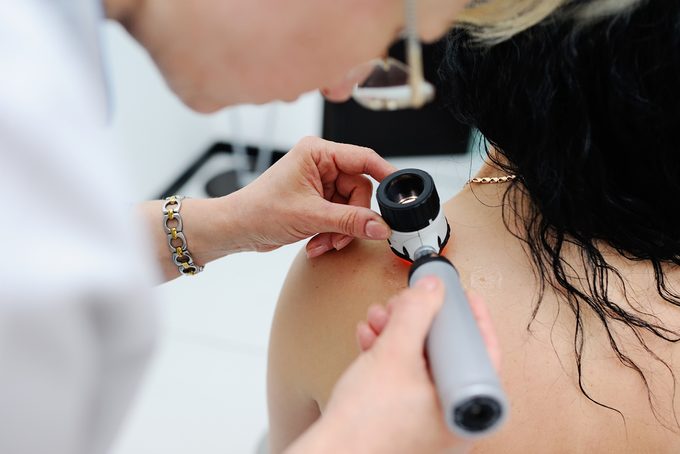The Warning Signs of Skin Cancer You’re Most-Likely Ignoring
Protect yourself by learning the easy-to-miss warning signs of the most common skin cancers.

You know the drill: Wear SPF, stay out of the sun and avoid tanning beds. We’re just not that great at practicing it. But we should be more sun smart, and be more aware of skin cancer warning signs.
The Canadian Cancer Society estimates that about 6,800 Canadians were diagnosed with melanoma in 2016, and 1,200 Canadians died from the disease.
Melanoma can develop from a pre-existing mole or a new spot that doesn’t look quite right. This is where the self exam for ABCDEs come in to play.
Precancerous spots
Many types of spots are not skin cancer warning signs but are considered precancerous spots, including actinic keratoses.
These scaly growths typically appear on sun-exposed areas, such as the face, shoulders, forearms and backs of the hands. They may initially be so small that they’re found by touch alone (it can feel as though you’re running your finger over sandpaper), but later they may become rough, raised areas of skin resembling warts. They might disappear and then reappear. If untreated, they can develop into non-melanoma skin cancer.
Up to 10 percent of actinic keratoses develop into squamous cell carcinoma (SCC) and, occasionally, basal cell carcinoma (BCC) – the two most common types of skin cancer.
Basal and squamous cell cancers
Because they rarely spread to other parts of the body, basal and squamous cell cancers are less concerning than melanoma, but they can be insidious the longer they’re left unaddressed, says Dr. Ken Alanen, a dermatologist, dermatopathologist and Mohs skin cancer surgeon in Calgary.
These cancers can be locally destructive to tissue and cause significant damage, particularly when they are on the nose, lip or eye. While melanoma is cancer of the cells that make pigment in your skin, BCC is cancer of the cells in the pores and SCC is cancer of the cells on the skin’s surface. “The difference between BCC and SCC is dolphin grey versus porpoise grey,” says Dr. Alanen. “They behave in almost the same way.”
Basal cell cancers are skin cancer warning signs that look like firm, flesh-coloured or slightly reddish bumps. They can be pimple-like growths that bleed, crust over and then reappear. Or they can be small, scaly red patches. Squamous cell cancers are usually red, scaly bumps or wart-like growths, but they can also look like open sores or crusted skin. About two to 10 percent of squamous cell carcinomas spread to the internal organs and are life threatening.
Talking to your doctor
One problem with both types of cancer is that they’re easily missed because they don’t cause symptoms, says Dr. Alanen.
But to a trained eye, they can be spotted, so a quick trip to see a doctor could be life-saving. Once, while getting off a plane, he tapped a stranger on the shoulder and said, “Hey, you have a basal cell carcinoma on the back of your neck – you should get it checked out.” People frequently mistake skin cancer for eczema, psoriasis, acne, warts or other common skin irritations, he says.
The problem is, doctors do, too.
Dr. Mariusz Sapijaszko, medical director of the Western Canada Dermatology Institute and Youthful Image Clinic, both in Edmonton, says he often sees patients who have had their skin treated repeatedly for benign conditions when the real culprit was cancer.
“If a therapy doesn’t solve the problem, you shouldn’t just repeat that therapy,” he says. “It’s time to get a biopsy or a referral to a dermatologist.”




